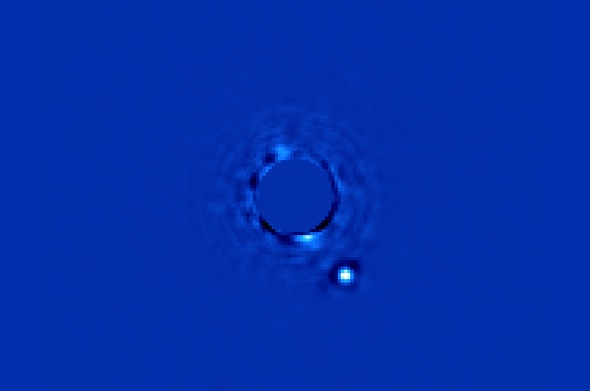Create a free profile to get unlimited access to exclusive videos, sweepstakes, and more!
The Gemini Planet Imager Is Ready to Explore Strange New Worlds

Get ready to see a lot of exoplanets images pretty soon: The Gemini Planet Imager is online and ready to seek out strange new worlds.
GPI is a camera that is used on the Gemini South telescope, an 8.1-meter behemoth located in Chile. GPI is the size of a small car and uses advanced optical techniques to provide incredibly crisp images of young planets orbiting distant suns. It will be able to clearly see exoplanets even when they are 10 million times fainter than their parent stars, and separated by as little as 0.2 arcseconds: Roughly the apparent size of a quarter 25 kilometers (16 miles) away! The camera is designed to look in the infrared; young planets (less than a billion years old) are still hot from their formation and glow brightly in infrared while stars tend to be dimmer in that light.
The first test runs were carried out in November 2013 and went very smoothly. When I saw the images, I literally gasped. GPI is a game-changer.
The image above, for example, shows the planet Beta Pictoris b, about 63 light years from Earth (the star itself was masked to reduce its light, and the planet is easy to spot.). The planet orbits its parent star in an ellipse that ranges from about 1 billion to 2 billion kilometers; roughly the same distance Saturn and Uranus are from the Sun, respectively. Itâs been seen before, but previous observations have taken long exposures to get good data. GPI can get pictures like that of Beta Pic b in mere minutes.Â
Amazing. Thatâs a planet, orbiting a star over 600 trillion kilometers away! And now, getting a picture of it is easy.
Multiple observations made over time will directly reveal the motions of planets as they orbit their stars, allowing astronomers to determine the shapes of the orbits. Not only that, but GPI can take a spectrum of the planet; it can break the incoming light up into separate colors, which astronomers can then analyze to obtain a treasure trove of info about the planet, including its atmospheric composition, temperature, and more.
The camera can also detect polarized light. Light scattered off dust can have its waves aligned in one direction, and this has many uses in astronomy (and in everyday life; sunlight is polarized by Earthâs air or when it reflects off various surfaces, so using polarized sunglasses cuts way down on glare. SCIENCE!). Observing just polarized light makes it easier to pick out dust orbiting a star, for example, and many young stars are still surrounded by clouds of dust left over from their birth. The shape of that dust cloud can tell us a lot about the star ⦠like in this fantastic GPI image of the star HR4796A:
HR4796A is a young star and is surrounded by a thin dust ring. On the left it shows the star and ring in normal light, and on the right is the image looking at just the polarized light. The light coming from the star itself isnât polarized, so it disappears, leaving just the dusty ring visible. This is in fact the best image of the ring Iâve ever seen (and I worked on Hubble images of this ring a few years back). The ring completely circles the star, but due to the geometry we see more polarized light coming from the back of the ring (to the right) than the front, so the back side looks brighter.
The ring is so narrow that it may be sculpted by the gravity of an unseen planet or planets; itâs hard to say. Images like this will go a long way toward figuring that out. And there are a lot of stars with dusty debris around them we can target with GPI.
I am very, very impressed with this machine. Over the next few years astronomers will embark on a survey to look at a stunning 600 young stars to look for planets around them; they expect to find dozens. Mind you, right now we only have about a dozen exoplanets total weâve directly photographed (the vast majority are found indirectly, by their effect on their stars). GPI will blow that number out of the water.
Iâve been saying for some time that with the recent advances in tech weâd be getting lots of exoplanets images soon. Sometimes I love being right. I canât wait to see what the next few years will show us.
Correction, Jan. 9, 2014 at 16:30 UTC: I had mistakenly swapped the front and back of the ring in the original version of this description, based on a) an embargoed version of the original press release, which was later revised, and 2) my own knowledge of these rings; another ring I read about had the front side more polarized than the back. This can depend on a lot of different factors, and may be different in different objects. My thanks to Randall Munroe for pointing this out to me!


























